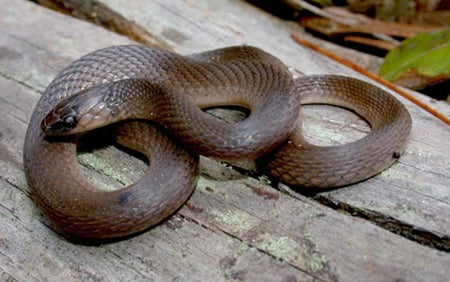SCIENTIFIC NAME:
Virginia striatula
STATUS:
Fairly common across most of Alabama, and present in all regions except Interior Plateau. Absent from northeastern portions of Appalachian Plateau and Ridge and Valley. More commonly encountered in Coastal Plain, and believed to have declined in recent decades. Lowest Conservation Concern.
DESCRIPTION:
Rough earth snakes are small fairly slender snakes, ranging from 7 to 12 ¾” in length. Their color varies, sometimes reddish brown, brown, or gray, and may be any shade between. Their scales are keeled and their snout is pointed. Their underbelly is a cream to yellowish in color that is not sharply defined from the color of their back. Young generally are darker colored than are adults, and may have a light band on the back of the head. This band sometimes is lost as individuals mature.
DISTRIBUTION:
In Alabama, rough earth snakes are fairly common throughout the Coastal Plain and lower portions of the Piedmont, Blue Ridge, and Ridge and Valley regions. They are absent from northeastern portions of the Appalachian Plateau and Ridge and Valley regions. Their range also extends east to Virginia, south to northern Florida, westward to eastern Texas, and north to southern Missouri.
HABITAT:
Rough earth snakes are found in a variety of forested habitats having abundant ground cover. Higher population densities exist in dry coastal plain woodlands, but rough earth snakes may be found on exposed, rocky, wooded hillsides as well as in heavily timbered uplands and valleys. They are most often found under leaves, decaying logs, sun-warmed rocks, or in compost piles and gardens.
FEEDING HABITS:
Rough earth snakes primarily feed on earthworms, slugs, snails, other invertebrates, and small frogs.
LIFE HISTORY AND ECOLOGY:
Although secretive in nature and rarely seen above the ground’s surface (fossorial), rough earth snakes are most active from March to late October. They give birth to 2-13 live young in mid- or late summer. Rough earth snakes often are found in association with eastern crowned snakes and copperheads. They are preyed upon by king snakes, eastern coral snakes, and shrews.
References:
Mount, Robert H. 1975. The Reptiles and Amphibians of Alabama. Auburn Printing Company, Alabama. 347 pp.
Knopf, Alfred A. 1979. The Audubon Society Field Guide to North American Reptiles and Amphibians. Chanticleer Press, Inc. New York, P. 678, plate 470.
Mirarchi, Ralph E. 2004. Alabama Wildlife, Volume One. The University of Alabama Press, Alabama, P. 127.
Author:
Jud Easterwood, Wildlife Biologist, Division of Wildlife and Freshwater Fisheries






